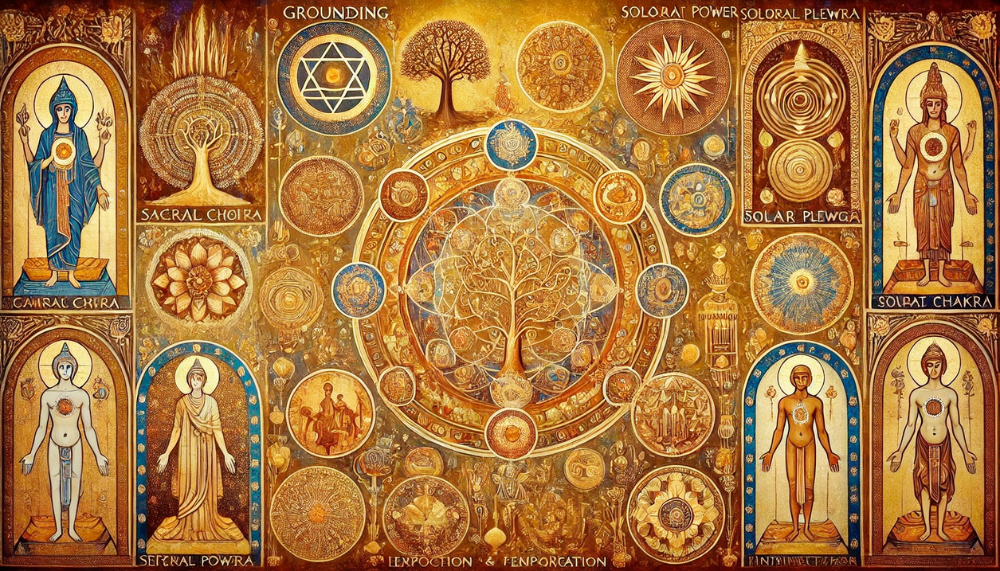The Spiritual Journey Of Ascender’s Prophecy
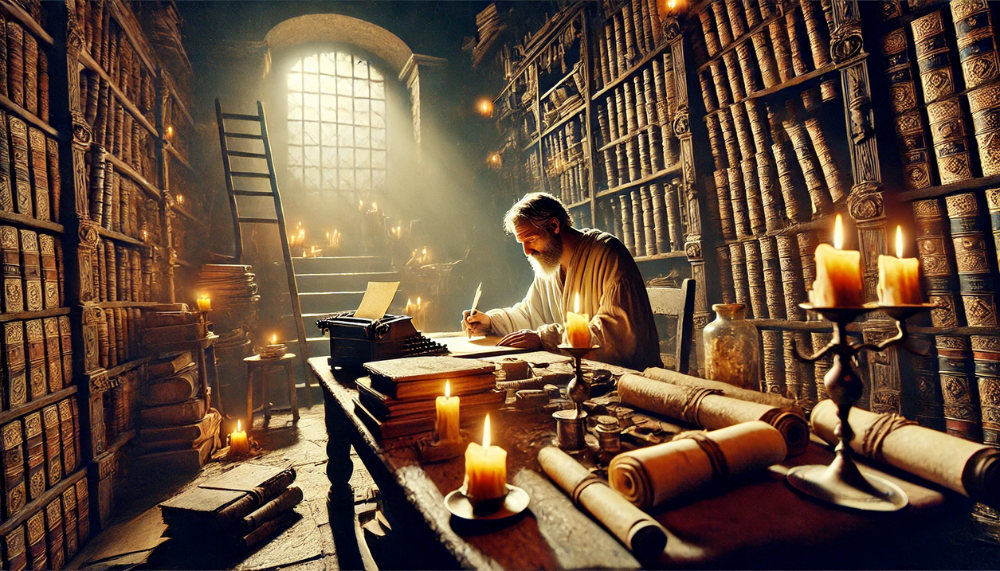
The unification of all belief systems is the domain of Theosophy, a nineteenth century philosophical movement that explored the unity of all religions. It’s fascinating for me to think that all the paths to enlightenment that humanity has developed over the ages, while appearing to be so distinct, all share a common goal. Basically, it’s the ascension of consciousness to a higher plane of existence. This is what the alchemists called turning lead into gold—a seven stage metaphor not for achieving physical wealth, but rather for spiritual transformation; for turning the base material of lead (our limited ego consciousness) into the pure gold of the higher-self consciousness, with all its wisdom, creativity, and power.
In Ascender’s Prophecy, I’ve managed to fit all these ancient teachings into a cohesive seven-step journey to enlightenment. Woven together are the arcane processes of alchemy, the ancient initiatory rites of the mystery religions, as well as the many teachings found in our six world religions. Central to this journey is the Compostela Cube, a prehistoric relic whose six faces represent the six world religions, each contributing an essential wisdom to the spiritual path. The Cube is an ancient artifact of advanced reptilian technology; a receptacle of the fragmented truths that humanity has amassed over the aeons. In the novel, Gabriel and Natasha’s task is to unlock the Cube’s secrets and unite these fragments into a cohesive whole that humanity’s collective consciousness can assimilate.
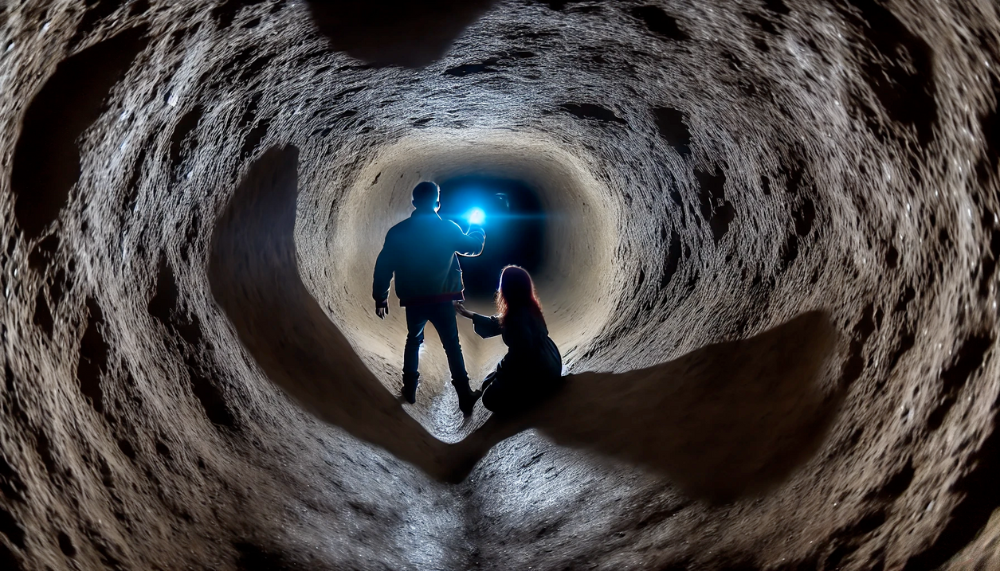
The Labyrinth of Sarras plays a central role in their journey as well. To me, the Labyrinth isn’t just a physical place; it’s also a symbol of the human psyche, in which every dark turn and uncertain twist brings you closer to the core of it all—the place where your true self resides. The sweltering passages that worm into the unknown reflect our inner struggles. They’re the doubts, fears, and tests we face as we seek to arrive at that higher state we know lies within us; the golden-glowing “me” that’s been covered in mud this whole time.
And so, as Gabriel and Natasha descend into this shadowy labyrinth to unlock the Cube’s Six Seals, they also move up through the body’s energy centres, or chakras, leveraging ancient esoteric knowledge along the way. Their mission is to regain the wisdom they once possessed in an ancient life incarnation, and use it to escape the Cube’s realty simulation and move into the higher spheres. Now, let’s dive into each level of the Labyrinth and the spiritual teachings it represents.
Level One – The Divine Action of Prajñā
The first Seal of the Labyrinth brings us to the Muladhara or Root Chakra, the foundation of our spiritual journey. This seal focuses on the necessity of grounding ourselves in truth—the truth of who we are, stripped of all illusions. In many ways, this step is about learning to see ourselves clearly, free from the false narratives we’ve internalized, and that run continuously in the backs of our minds.
Here in this first Seal, Gabriel and Natasha decipher the Buddhist contribution to the Cube’s gnosis, the Divine Action of Prajñā. Prajñā is all about wisdom, discernment, and seeing things as they truly are, not as we’d like them to be. What strikes me most about this concept is that it begins with the self. According to this wisdom, you can’t see the world clearly until you see yourself clearly. It’s all about learning to question the beliefs you’ve always held about yourself, particularly those formed in childhood, when your understanding of the world was limited. This is where true self-knowledge begins.
At this first level, we encounter the first alchemical stage of Calcination. In this context, it’s in the burning away of the ego’s pride, the single most important obstacle to spiritual evolution. Calcination is brutal, as it demands complete honesty with ourselves. It’s a process that feels like being burned; burned by the fire of introspection. It’s this stage that strips away our masks, forcing us to confront the uncomfortable parts of ourselves we’d rather ignore.
The riddle for this seal offers clues to the process of self-truth:
The eyes of the mind are many.
The truth is always illusive.
An infant’s vision is nearsighted.
Its conclusions must always be questioned.
In the Royal Palace,
Bejeweled curtains are never hung where there are no windows.
Therefore, the Two say:
Better an ugly hole in the wall
And self-loathing.
To seek perfection is noble.
To embrace imperfection is majestic.
What I find so powerful here is the idea that imperfection is something to be embraced, not hidden. The line “better an ugly hole in the wall and self-loathing” speaks to the importance of facing our flaws head-on, rather than covering them with ego-driven pretenses. There’s a majesty in owning our imperfections, in seeing ourselves as we truly are, because that’s where real growth begins.
For the initiate, this Seal marks the beginning of their journey inward, where they must question the beliefs they’ve carried since childhood; the beliefs that have shaped their sense of self, or in other words, their ego identity. In doing so, they’ll begin to see glimpses of a higher-self that’s been hiding in plain sight the whole time.
Level Two – The Divine Action of P’u

The second Seal plunges us deeper into the Labyrinth, guiding us toward a more complex understanding of the self. Here, we come to the Swadhisthana, or the Sacral Chakra, which governs emotions, creativity, and unconscious desires. Now that the initiate has overcome the pride that would have normally stopped further progress, it’s now time to confront the hidden parts of ourselves—the shadow aspects that are often too difficult or uncomfortable to acknowledge.
At this level, Gabriel and Natasha reflect on the Taoist contribution to the Cube, the Divine Action of P’u, or the Uncarved Block. The concept of P’u is one of neutrality—seeing things as they truly are, without judgment. What resonates with me most here is that P’u suggests that good and bad are merely labels that the mind imposes on the reality we perceive. In their purest form, and apart from personal and societal judgments, things just are.
This level leverages the next stage in the alchemical process—Dissolution. In this powerful step, the rigid constructs of judgment and classification are dissolved, opening us up to a broader perspective. In the end, it’s about dissolving the ego’s survival-based need to label everything, ultimately allowing us to view even the negative aspects of ourselves as small parts of a larger whole. The previous stage exposed our imperfections; now, we begin to see that these imperfections are not inherently bad, but rather part of a larger truth.
The riddle for this seal offers insight into this idea:
When searching for something that is lost,
One first finds the places where it is not.
In a bowl of bitter salt crystals lies a diamond in the rough.
Each piece is tasted until the treasure is found.
Therefore, not finding leads to finding,
And bitterness becomes sweet.
The Two find the One by finding the places where it is not.
They look to the left and to the right,
And loath not the seven sins that lie there.
Although veiled in darkness, the sins are a blessing,
For they point to the Kingdom that was lost.
What stands out to me most is the line, “bitterness becomes sweet.” It reminds us that by confronting the unpleasant aspects of ourselves, we’re actually moving closer to the truth. The dressing mirrors in the chamber where Gabriel and Natasha encounter this seal, represent the seven deadly sins. They offer distorted reflections of their viewer, emphasizing that these sins are nothing more than misconceptions—misunderstood parts of the self. Yet, as the riddle also suggests, those very misconceptions can lead us back to the heavenly kingdom that we left long ago.
The alchemical stage of Dissolution works in perfect harmony with this seal. By dissolving our judgments and seeing our shadow aspects for what they truly are—neither good nor bad, but rather small parts of a larger whole—we free ourselves from the need to hide or suppress these parts. Instead, we can embrace them as part of our ongoing evolution, and this, in turn, unlocks our potential for true creative power because the anchor of guilt and unworthiness has been lifted.
As the water in the pool clears to reveal the second portal, Gabriel and Natasha understand that this journey is not about eradicating sin or imperfection. It’s about recognizing that even the shadow has its place, and only by embracing the whole of ourselves can we move forward on the path to self-realization.
Level Three – The Divine Action of Jihad Bil Qalb
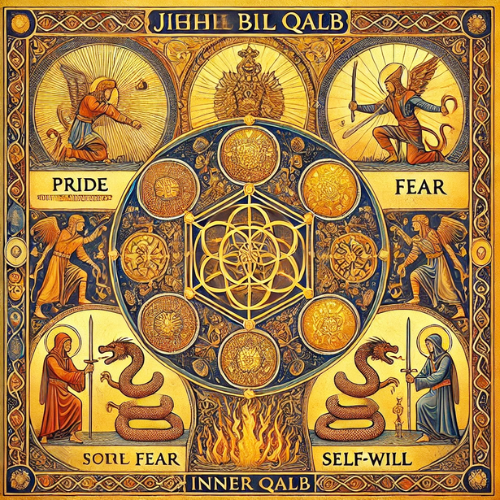
At the third level of the labyrinth, we’re introduced to the Manipura, or the Solar Plexus Chakra, which governs personal power, will, and in this case, the Inner Warrior. This is where the battle against the lower self begins in earnest. Leveraging what they’ve learned in the past two Seals, initiates can now begin to face their inner demons and false gods.
At this stage, the religious contribution comes from Islam, with the concept of Jihad Bil Qalb, or the Inner Struggle. Often misunderstood, this jihad is not about external battles and conquest, but rather the war we wage with our inner demons—those forces that twist truth, inflate pride, and breed fear. This level of the Labyrinth is about beginning to unmask the false self to reveal the higher self beneath.
Here we arrive at the alchemical stage of Separation, where truths are separated from falsehoods. The faults that were unearthed and dissolved in the previous stages are now analyzed so that their causes can be understood. Here, the initiate discerns between the ego’s lies and the truth of the higher-self. In order to unlock the Seal and move forward on their journey, Gabriel, and thus the initiate, must confront the three Wormlords, each a personification of pride, fear, and self-will (which is more like selfish-will, and not to be confused with free-will).
The riddle for this seal offers guidance:
At the root of all evil lies the triad of death.
Self-will endeavors to confuse and twist the truth.
Pride limits vision to all but what is apparent.
Fear labours incessantly to separate and divide.
The warrior crosses the threshold and passes into the realm of shadows.
He engages his enemies and so obtains the three keys of purification.
When mother and father are seen in truth,
Religious tradition can be questioned.
Enmity then becomes tolerance,
And tolerance becomes Unity.
After the false god has been slain,
What before seemed impossible, becomes feasible.
Only when the triad is revealed and conquered,
Can there be unity between all nations and creeds.
This level of the Labyrinth is about facing the Triad of Death. According to these ancient wisdoms, self-will, pride, and fear lie at the root of all human suffering. The three Wormlords represent this triad, and together they work to cloud our judgment and keep us trapped in materialism and separation. What’s more, wherever one element of the triad is present, the other two will be present as well. Gabriel’s victory over the Wormlords symbolizes the initiate’s ability to break free from these forces by confronting them head-on.
In the novel, the dragon Ialdabaôth is the false god, representing the ego’s distorted idea of God. Ialdabaôth is an obsolete, ego-based deity that humanity has long outgrown. To slay this dragon is to release ourselves from all false concepts of God, allowing us to see the truth within and beyond religious dogma and outdated traditions.
In this seal, the alchemical stage is Separation. Much like separating alloys of metal in a molten slurry, this mystical step is about discerning the truth from the lies that we’ve inherited from religious leaders and societal norms. It’s about understanding that much of what we’ve been taught is both true and false at the same time, and the only way forward is to separate the real wisdom from the misconceptions, as opposed to throwing out the proverbial baby with the bathwater.
By conquering the Wormlords and slaying the dragon, Gabriel and Natasha unlock the third seal, embodying the power of the Inner Warrior. This level of the Labyrinth reminds us that the real battle is always within, and only by facing and defeating our internal demons can we ascend to a higher state of consciousness.
Level Four – The Divine Action of Atma-Jnana

At this stage, Gabriel and Natasha arrive at the Anahata, or Heart Chakra, representing love, compassion, and emotional balance. This chakra is key to uniting the lower ego withthe higher-self. The world religion contribution in this Seal comes from Hinduismin the form of Atma-Jnana, or Self-Realization. This teaching is about recognizing one’s true self and its oneness with Brahman, or God. In this level, initiates transcend the illusions created by the ego and embrace their divine core.
The alchemical stage tied to this level is Conjunction, the bringing together of two parts to make a single element. As Natasha explains, it’s not about destroying the lower-self, but rather about re-educating it. This process requires compassion and patience, as the lower-self must mature and be guided into alignment with the divine core.
The riddle for this Seal highlights the barriers to self-realization and the work required to overcome them:
The Two look inward to the divine core,
But first come to the walls that enclose it.
One is of deception.
The other of misconception.
There is a fragment here that never sleeps.
To transcend it one must be relentless.
If the child is to mature,
The teacher must be patient.
Only then can the apprentice become the master.
This level of the Labyrinth deals in part with the mask-self, a false identity formed in our childhood to gain approval and love. The mask-self is a deception and must be dissolved to access the true self. Beneath the mask-self lies the lower-self, and together they comprise the lower-ego, which is childlike, selfish, and full of misconceptions. In this same construct resides the higher ego as well. It’s the adult element of the two, and it’s already in touch with the higher-self to some extent. Rather than destroying the lower ego, the goal is to use the higher ego to help it grow up. This is done through the love and compassion that’s found in the Heart Chakra. The ultimate aim here is to merge the lower ego with the higher ego, and then merge the higher ego with the divine self to become the Jivanmukta.
In the riddle, the lower ego is referred to as “The fragment that never sleeps” because it always resists change. It fears annihilation if the higher self were ever to take over, but as Gutierrez explains, this is an illusory fear. The ego is never destroyed, for it is a part of the whole personality and has its place. The initiate must repeatedly confront and overcome its resistance however, allowing the divine core to finally guide the personality towards union and self-realization.
Once the initiate dissolves the mask-self, they understand that the way forward is through patience and persistence, teaching the lower ego so it can grow and ultimately align with the higher ego and ultimately with the divine self. The apprentice then becomes the master, as the riddle concludes.
Level Five – The Divine Action of Logos
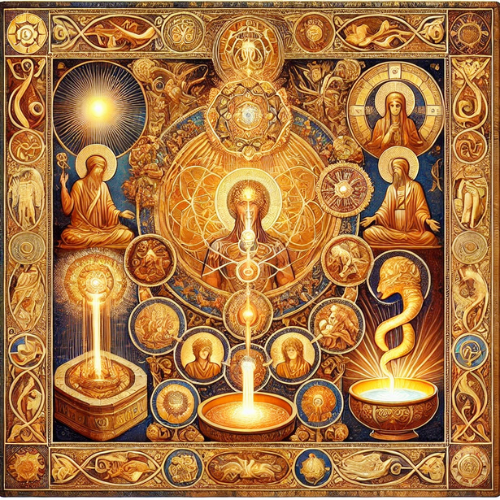
At this level of the Labyrinth, Gabriel and Natasha find themselves tackling the Vishuddha Chakra, or the Throat Chakra, which governs expression, hearing, and the power of the Word. This is the seat of divine communication, and in this level, they unlock the Divine Action of Logos—the Christian contribution to the Cube’s gnosis.
The alchemical stage tied to this seal is Fermentation, where the combined elements that were acquired through Conjunction undergo transformation into a higher, more purified state. In the case of the Cube’s gnosis, it’s this process by which all the knowledge and wisdom acquired from the previous seals is allowed to merge, mature over time, and transform. Fermentation refines the initiate’s understanding, enabling him or her to apply their wisdom toward manifesting their desires through Logos—the Word of Creation.
As Gutierrez explains, desire is much like a sculptor’s clay. It’s mouldable, but its mastery requires balance, and the renunciation of self-will. Desire, when healthy, leads to creation, but when poisoned with self-will, pride, and fear, its very power sabotages the creative process. For the life-force to fulfill our desires, we must approach our desires without urgency, in a state of contentment and trust.
This understanding is reflected in the riddle
In the soil of the Earth there exists a power that brings forth life,
Yet it cannot be seen.
In the depths of the ocean there exists a power that sustains the world,
Yet it cannot be seen.
In wind, and in fire, there exists a power that governs all existence,
Yet it cannot be seen.
Therefore, that which is invisible is the true power,
And that which can be seen is the result of it.
Earth, water, wind, and fire are servants of the Master.
The Two speak the Word and are obeyed.
Mighty is he who knows the invisible.
The power of powers will be his to command.
Cursed is he who is blind to the invisible.
His struggle will only cease when the poison has been revealed.
This riddle emphasizes that Logos is an invisible power, a creative force that governs all of reality. Gabriel and Natasha reveal that the initiate must learn to speak the Word, not only consciously but also unconsciously, ensuring that their inner words—their thoughts, emotions, and intentions—are aligned with truth and love, and not poisoned by hidden doubts, fears, or ulterior motives.
Gabriel realizes that most of us unknowingly speak poisoned words against our own desires, which blocks their manifestation. The key to mastering the Dive Action of Logos is recognizing these inner contradictions, slowly clearing them out, and replacing them with healthy, harmonious thoughts. As Gutierrez explains, true wealth comes from understanding that abundance is an inner state of being, not a result of external circumstances.
The riddle continues:
Wealth cannot come from poverty.
Abundance cannot be born from lack.
Therefore, the Master finds the great richness within.
He sees what he desires and possesses it in faith.
He tempers his will and waits patiently for the arrival.
In this way he brings heaven to the earth.
Through this understanding, Gabriel and Natasha unlock the fifth Seal revealing that, in addition to speaking the Word of Creation, an initiate’s ability to manifest his or her desires comes from realizing their true inner richness.
Level Six – The Divine Action of Binah-Chokhmah
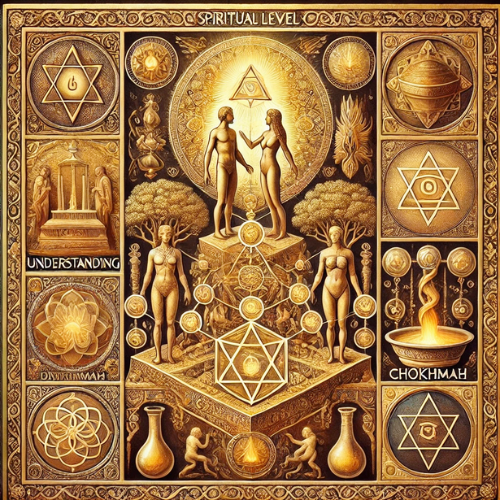
The Sixth Seal brings Gabriel and Natasha to the Ajna or Third Eye Chakra, the seat of intuition and insight. This penultimate stage is about seeing through the illusion of separation, and embracing Unity Consciousness. The world religion contribution here is from Judaism, specifically the Sephirot of Binah and Chokhmah—the spheres of Understanding and Wisdom on the Kabbalah’s tree of life. In the mystical Jewish tradition, Binah represents the feminine, while Chokhmah represents the masculine. Their fusion creates a state of Unity Consciousness, which is the key to transcending duality and passing through the Seventh Seal to the higher spheres.
In this level, Gabriel and Natasha descend into the lower cabin of a mysterious boat, finding there an opulent and otherworldly room. It’s a scene I took directly from of Chrétien de Troyes’s Quest for the Holy Grail. The cabin’s canopied bed is made of boughs from the Tree of Life, and Gabriel and Natasha eventually realize that the berth was made specifically for the mystical purpose of Mithuna, or tantric union. They also see how it is directly tied to the final stage of their journey, where they will need to fuse as a single entity through an Alchemical Marriage.
Beneath the magical bed they find the Sixth Seal, corresponding to the Ajna, or the Third Eye Chakra. This energy centre represents the ability to perceive beyond duality and into the realm of Unity Consciousness. The alchemical stage connected to this seal is Distillation, where everything that’s been learned up to this point is purified and transformed into its highest, most refined state.
The riddle is short and to the point.
The gateway to heaven is the Mother of All,
It resides at the centre of the universe.
In this place the many people are but one,
And the ten thousand places the same.
To transcend the Cube is to see it in all things.
Short as it is, Gabriel and Natasha still puzzle over it. Here they must leverage the power of Binah (Understanding) and Chokhmah (Wisdom)—the feminine and masculine principles—in order to become One. This fusing together will achieve the final alchemical stage of Coagulation, the ultimate transformation of the unified soul.
The understanding they seek lies in the realization that All is One, and soon Gabriel and Natasha begin to remember the true nature of Unity Consciousness. They begin to see how every person and every place in existence is merely a fragment of a greater whole—literally a piece of the self-same consciousness. Gabriel makes the thought-provoking observation that every human mind in existence is part of a single, fragmented, and very confused greater-mind. The many people, as the riddle says, are but one.
A good analogy would be a schizophrenic’s mind, which can create many different personalities each with their own respective minds, despite the fact that all those minds are part of the same mind—the schizophrenic’s mind. This observation, coupled with what they experience while astral travelling in Mithuna, leads Gabriel and Natasha to the profound realization that the single user slot in the Cube’s reality simulation is specifically for God to use, in that everyoneandeverything is God—an interconnected part of a single, divine consciousness that was fragmented long ago, only to now experience itself through the Cube’s multidimensional interface. Why? So that it might become whole once again.
With this revelation, Gabriel and Natasha find themselves on an another astral journey while in Mithuna, this time to the Helix Nebula, also known as the Eye of God. Here, they experience the center of the universe as the source of the universe; a universe that is being projected outward into empty space by the consciousness within them. Gabriel observes that if the conscious observer (you, me, them) is surrounded by infinity in every direction (which we all are) then there is only one place that this observer can be—at the centre of the universe. In this place, the many people are all contained within this observer’s projection, as are the ten thousand places. What this means is that everything that can exist, exists inside the universe that you project. In other words, everything exists within you. All is One.
Because this fact applies to every conscious entity, there only needs to be one user slot in the Cube’s simulation interface. The Seventh Seal is that user slot, and it’s not somewhere out there in the cosmos, but rather within. It’s inside each of us, waiting to be unlocked and traversed. The gnosis of the Sixth Seal reveals that the Gateway to Heaven (the Seventh Seal) opens through the acquisition of Unity Consciousness, which becomes the precursor to ascension. In this way, Gabriel and Natasha, having now remembered all the wisdom they possessed as the reptilian King and Queen, merge into one entity and pass through the final Seal, fulfilling the Ascender’s Prophecy and opening the way for humanity to follow.
AVAILABLE IN PAPERBACK, EBOOK, AND AUDIOBOOK
